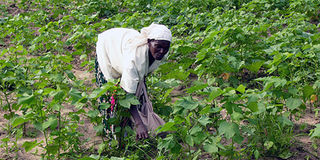Kenyans now told to prepare for dry spell

Daniel Nyassy | Nation
Frida Njeri tends her cotton crop at Bahari village, Mpeketoni, Lamu district. The weatherman has predicted poor crop due to low rainfall.
What you need to know:
- Latest weather advisory by the Met says this year’s long rains won’t be enough for a good crop
Kenyans should brace themselves for tough times ahead as this year’s long rains, which usually reach their peak during April, have fallen below expectations.
According to the latest weather advisory from the Meteorological Department, farmers can expect poor crop performance, with those planted at the onset of the rains wilting due to prolonged dry spells.
The Department says rainfall recorded from the beginning of this month to date shows “very low-key rainfall activities over most parts of the country”.
“This is a continuation of the dry conditions that started in the last week of March and depicts a prolonged dry spell over most parts of the country into this usually peak rainfall month of April,” said Dr Joseph Mukabana, the director of Meteorological Department.
He said the trend is likely to continue over the next seven days, with most parts of the country getting very low rains.
“Only patchy and light rainfall is expected over the coastal strip, parts of the southeastern lowlands, parts of the northeastern areas, the central highlands and the western areas,” said Dr Mukabana.
The latest advisory should serve as a warning to farmers and pastoralists as well as the government and agencies that deal with agriculture and food supply.
Low harvest
This means the prices of food, mainly staples like maize, rice, bread and beans -- already on an alarming increase -- could rise further as shortages begin to bite.
The weatherman warns that the effects of the poor rainfall will be seen in wilting of recently planted crops as well as poor pasture.
Inflows of water into the Seven-Forks, Turkwel and other hydroelectric power generating dams, due to erratic and low rainfall in the catchment areas in the highlands, could also affect the availability of electricity.
Kenyans should also watch out for diseases associated with water scarcity and poor sanitation such as typhoid and cholera.
There are also likely to be conflicts over limited water resources in the arid and semi-arid areas, said Dr Mukabana.
The latest weather advisory comes in the wake of opinion polls showing Kenyans are alarmed over the rising cost of food, especially the staples, and that of fuel.
There have also been concerns that the government has been slow to distribute subsidised seed and fertiliser to farmers in parts of the country, considered to be the main sources of the staples.
Fertiliser factor
Concerns over Kenya’s dependence on imported fertiliser led to the adoption of a motion in Parliament on Wednesday seeking to compel the government to set up a fertiliser factory in Kenya as soon as possible.
But, according to the Agriculture ministry, that can only be done starting the next financial year, with completion of the project possibly coming after next year’s General Election.




